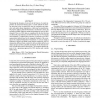Free Online Productivity Tools
i2Speak
i2Symbol
i2OCR
iTex2Img
iWeb2Print
iWeb2Shot
i2Type
iPdf2Split
iPdf2Merge
i2Bopomofo
i2Arabic
i2Style
i2Image
i2PDF
iLatex2Rtf
Sci2ools
101
Voted
ICASSP
2008
IEEE
2008
IEEE
Mutual information based relevance network analysis: a Parkinson'S disease study
Monitoring the dynamics of networks in the brain is of central importance in normal and disease states. Current methods of detecting networks in the recorded EEG such as correlation and coherence only explore linear dependencies, which may be unsatisfactory. We propose applying mutual information as an alternative metric for assessing possible nonlinear statistical dependencies between EEG channels. However, EEG data are complicated by the fact that data are inherently non-stationary and also the brain may not work on the task continually. To address these concerns, we propose a novel EEG segmentation method based on the temporal dynamics of the crossspectra of computed Independent Components. A real case study in Parkinson’s disease and further group analysis employing ANOVA demonstrate different brain connectivity between tasks and between subject groups and also a plausible mechanism for the beneficial effects of medication used in this disease. The proposed method appears to be...
Related Content
| Added | 30 May 2010 |
| Updated | 30 May 2010 |
| Type | Conference |
| Year | 2008 |
| Where | ICASSP |
| Authors | Pamela Wen-Hsin Lee, Z. Jane Wang, Martin J. McKeown |
Comments (0)

